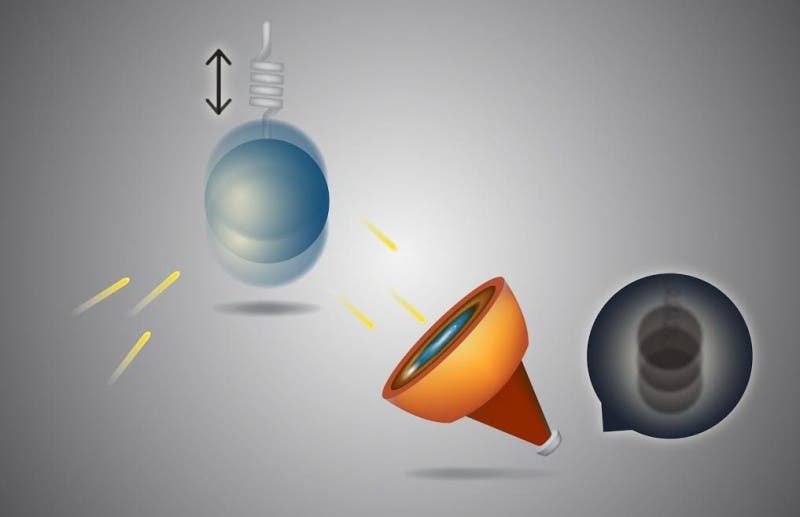Researchers have detected the smallest force ever recorded – 42 yoctonewtons – using a system of super-cooled atoms.
Yocto-what?

Credit: Image by Kevin Gutowski
The Newton, named after sir Isaac Newton, is the international unit of measure for force. 1 Newton is equal to 1 kilogram times 1 meter over 1 second square (1N = 1 kg * 1 m / s^2). A yoctonewton is one septillionth of a newton – or in other words, 0.000000000000000000000001 newtons.
Scientists working at the Lawrence Berkeley National Laboratory (Berkeley Lab) and the University of California (UC) Berkeley used a system of lasers and a cloud of ultracold atoms to measure the force.
“We applied an external force to the center-of-mass motion of an ultracold atom cloud in a high-finesse optical cavity and measured the resulting motion optically,” says Dan Stamper-Kurn, a physicist who holds joint appointments with Berkeley Lab’s Materials Sciences Division and the UC Berkeley Physics Department. “When the driving force was resonant with the cloud’s oscillation frequency, we achieved a sensitivity that is consistent with theoretical predictions and only a factor of four above the Standard Quantum Limit, the most sensitive measurement that can be made.”
This is not just a significant breakthrough in itself, but it could have significant results in the future. As scientists study (directly or indirectly) more and more tiny things, more accurate ways of detecting forces and interactions are necessary. For example, at the Laser Interferometer Gravitational-Wave Observatory (LIGO), scientists are attempting to record motions as small as one thousandth the diameter of a proton.
Changing things by measuring them
However, there’s a big problem with measuring tiny things. As you get to smaller and smaller scales, quantum effects start to kick in – and they can really mess things up. According to the Heisenberg uncertainty principle, you change the outcome of a value if you measure it – yes, that’s how quantum mechanic works sometimes. As these measurements of force are done with mechanical oscillators, when you get to the quantum scale, the measurement itself affects the osscilator. This barrier is called the Standard Quantum Limit (SQL). In the past couple of decades, scientists have come up with a myriad of creative (yet imperfect) ways of working around the SQL. However, none of them came even close, failing by over 6 orders of magnitude! Until now, that is.
“We measured force with a sensitivity that is the closest ever to the SQL,” says Sydney Schreppler, a member of the Stamper-Kurn research group and lead author of the Science paper. “We were able to achieve this sensitivity because our mechanical oscillator is composed of only 1,200 atoms.”
In their experiments, they set up two equal and opposite optical fields and applied them onto a gas of rubidium atoms optically trapped and chilled to nearly absolute zero. The response is measured using a probe beam with a wavelength of 780 nanometers.
“When we apply an external force to our oscillator it is like hitting a pendulum with a bat then measuring the reaction,” says Schreppler. “A key to our sensitivity and approaching the SQL is our ability to decouple the rubidium atoms from their environment and maintain their cold temperature. The laser light we use to trap our atoms isolates them from external environmental noise but does not heat them, so they can remain cold and still enough to allow us to approach the limits of sensitivity when we apply a force.”
He believes that they can go even closer to the SQL, though not much closer.
“A scientific paper in 1980 predicted that the SQL might be reached within five years,” Schreppler says. “It took about 30 years longer than predicted, but we now have an experimental set-up capable both of reaching very close to the SQL and of showing the onset of different kinds of obscuring noise away from that SQL.”






